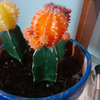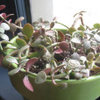Welwitschia mirabilis
Anyone else growing this curiosity? It is a strange, marginally succulent plant from Namibia, that only ever has two real leaves. The strap-like leaves continuously grow from the base to astounding lengths, eventually forming piles that help collect fog-water to sustain the plant. There are lots of good articles about this plant, but this one has some good habitat photos: Welwitschia mirabilis.
I've had a small one for about a year, and just bought another since the grower is getting low on stock. He grows them from a seed producing pair in turn grown from collected seed. Here are a couple photos I took while I potted it. Maybe some day I'll end up with a viable pair myself, I've got a 50-50 chance!
{{gwi:628383}}
They come in 10" tall "rocket-pots". There is some debate as to whether the extra depth is necessary or not. Most people still grow them in extra deep containers, but there is a growing number that just use regular pots.
{{gwi:628384}}
Apparently, not disturbing the rootball while repotting is essential to keep them going. You can see the structure the leaves grow from pretty well. Those leaves are just over an inch wide.
{{gwi:628385}}
I put it in an 11" tall, 4" diameter pot.
{{gwi:628386}}
A close-up of the growing point from the top.









caudex1
mark4321_gw
Related Professionals
Marco Island Landscape Architects & Landscape Designers · South Orange Landscape Architects & Landscape Designers · Finneytown Landscape Architects & Landscape Designers · Wake Forest Landscape Contractors · Choctaw Landscape Contractors · Golden Landscape Contractors · Matteson Landscape Contractors · North Smithfield General Contractors · Riverdale General Contractors · Sauk Village General Contractors · Waianae General Contractors · Ossining Carpenters · Baton Rouge Decks, Patios & Outdoor Enclosures · King of Prussia Decks, Patios & Outdoor Enclosures · Wheaton Decks, Patios & Outdoor Enclosuresdufflebag2002
stanofh 10a Hayward,Ca S.F. bay area
xerophyte NYC
joscienceOriginal Author
stanofh 10a Hayward,Ca S.F. bay area
joscienceOriginal Author
dufflebag2002
cactusjordi
stanofh 10a Hayward,Ca S.F. bay area
tunilla
summersunlight
cactusmcharris, interior BC Z4/5
nomen_nudum
mfyss
PEDRO ISAAC
cactusjordi
PEDRO ISAAC
O J
PEDRO ISAAC
stanofh 10a Hayward,Ca S.F. bay area
PEDRO ISAAC